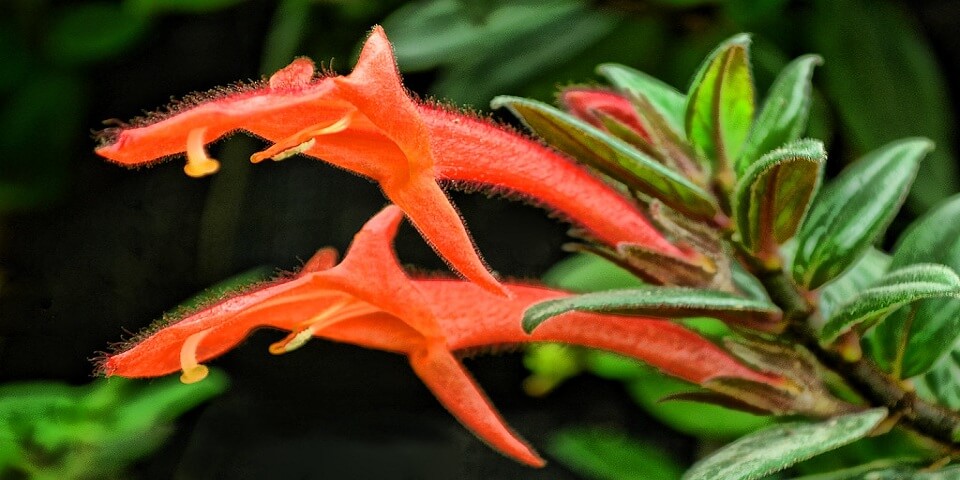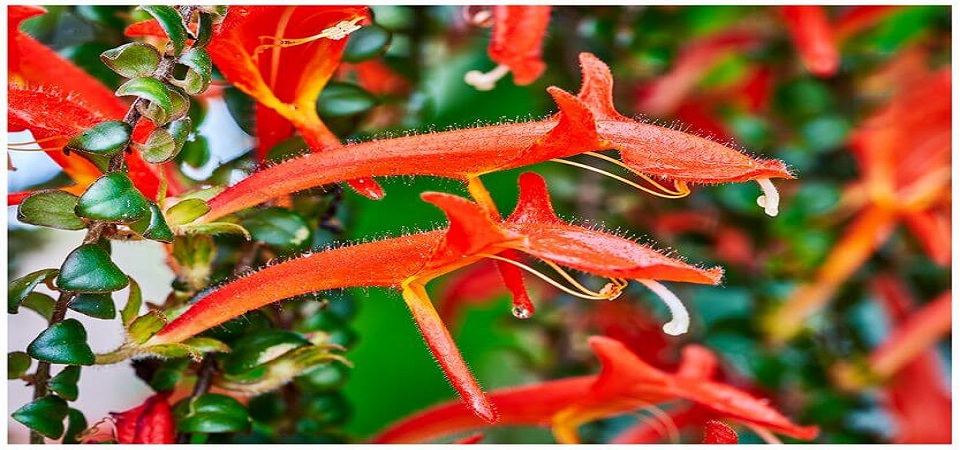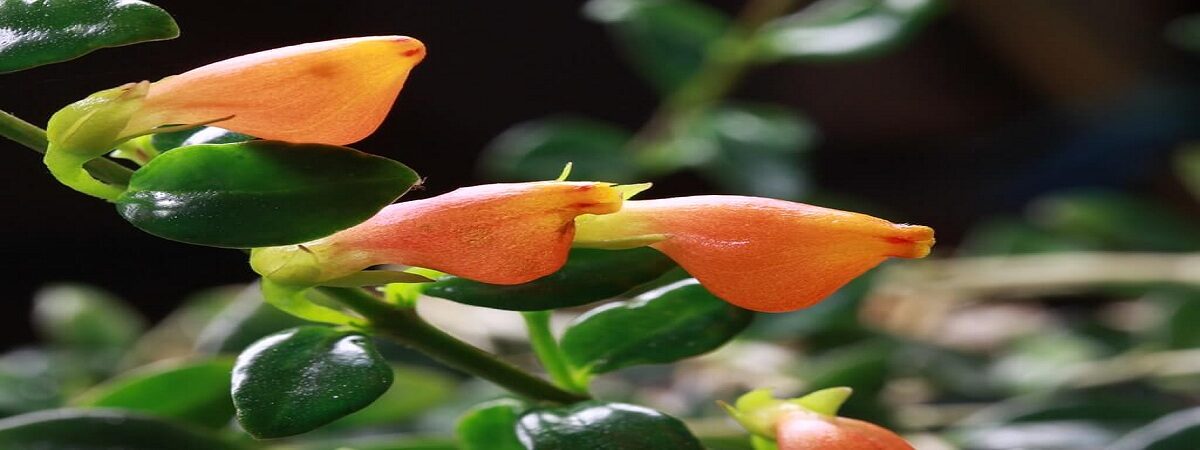Do you want to add some more beauty to your garden? Then you should definitely look for Goldfish plants to add some beauty to your garden.
Goldfish plant scientifically known as Columnea gloriosa originated from Central and South American tropics. They belong to the Gesneriaceae family, and it has another species that is scientifically known as Columnea nematanthus.
Hence, it is always best to check the scientific name before planting these plants. Goldfish plants are epiphyte in nature and are perennial. They can live upto 10 years if proper care is given.
These plants are a great addition to your houseplants collection and will enhance your hanging garden too as these are best grown in hanging gardens as their shoots are hanging in nature and can grow upto 3ft(95 cm).
The plant got its name “Goldfish” due to the shape of its flower that somehow resembles a fish and has a golden color. They have thick wax like dark green colored leaves.These plants are neither toxic to humans nor to cats and dogs.
Varieties of Goldfish plant
Columnea gloriosa has a popular cultivar called ‘Superba”. A dark maroon leaf covered in fine hairs characterizes this variety.
Numerous cultivars are hybrids of the Columnea genus, including gloriosa. Gold Spice, Lava Flow, and Orange Sherbert are some of them.
Red flowers and dark-green leaves distinguish ‘Firebird’ and ‘Aladdin’s Lamp’. ‘California Gold Has yellow blooms laced in red that make it a beautiful houseplant. ‘Chanticleer’ is an abundant bloomer with a compact habit.
How to grow and care for Goldfish plants?

Goldfish plants are a great treat to the eyes when they bloom in hanging baskets. So in order to see them blooming you need to take proper care of the plant.
So here is a proper guide to give you a clear idea on what type of soil, climatic conditions, fertilizers, propagation technique are required to grow these beautiful plants in your garden.
Soil
As Goldfish plants are epiphytes, which means they grow in trunks of trees and really don’t need soil to grow. When you are growing these plants indoor proper soil mix is best suited.
It should have proper drainage. You can use coarse sphagnum moss, perlite, or vermiculite in equal amounts.
Apart from these, you can also choose a hydroponics method to grow these Goldfish plants.
Hydroponics is basically growing plants without soil.
Light
Goldfish plants require enough light but they cannot tolerate direct sunlight. The leaves will turn to brown if they get exposed to direct sunlight.
So it is best to plant them in an east facing window where they won’t be getting direct light. But you need to give them 12 hours of light everyday to bloom.
Temperature
As these Goldfish plants have originated from tropical areas they need warmer temperatures. Hence the flowers bloom usually in the warm season. They can easily withstand average room temperature and hence are a great choice for houseplants.
Ideal temperature is 65-80°F/18-27°C. They cannot usually tolerate cold as it causes their leaves to fall off.
Humidity
Like other tropical plants, they require high to moderate humidity and regular misting of water is beneficial for the plants. It’s best to keep the humidity above 60%.
Water
Watering your Goldfish plants is quite a tricky method. You need to be very careful while choosing when your plants require water. They require more water in spring and summer but less water in winter.
However the soil should be kept a bit moist during summer and spring. But in winter you need to water only after the soil has dried out slightly, not completely.
Cold water is a complete no no for these plants as brown spots will appear on leaves rather it is best to use tepid water for all your houseplants.
Fertilizer
Like every other plant, Goldfish plants require nutrients for their growth too. Micronutrients containing fertilizer are good for these plants.
Phosphorus fertilizer works best for Goldfish plants especially during their blooming season i.e. in spring and summer every 2 weeks either through watering it to the soil or spraying it to the leaves.
In winter, less application of phosphorus fertilizer is required i.e. once a month is enough. But be careful regarding dosages as overfertilization will harm your goldfish plants.
Propagation of Goldfish plants

When it comes to the propagation part these Goldfish plants are easy to propagate. Goldfish plants are propagated through stem cuttings. Propagate your plants in summer and spring.
First, remove the stem tip with shears. It should be between 4 and 6 inches long and have at least two leaves
Then insert these cut ends in slightly moist potting mix soil after dipping in rooting hormone powder for better success. Remember to put only an inch of the cuttings inside soil.
After these, keep these cuttings in a humid and bright area as you have done it for older plants. After 4 weeks, see these plants to start rooting and wait for summer to see your goldfish plants blooming.
Pruning
Goldfish plants grow profusely and vigorously, rather than growing tall they grow in cascade downwards. It’s good to trim for their better growth.
Older and excessive vegetative growth must be removed to increase flowering. It’s better to do it in late winter or early spring.
Problems of Goldfish plants
Like every plant, some problems might occur in your goldfish plants too.
Less flowering
Lack of phosphorus in soil can lead to less flowering. So you need to focus on applying phosphorus fertilizer more at the time of flowering
Brown leaf tips
Excessive calcium in the soil can cause leaf tips of plants to turn brown and hence it is recommended to apply fertilizer that doesn’t contain calcium more. You shouldn’t use tap water for watering instead distilled water can be used.
Spider mites
Another devil is Spider mites. These are so tiny that you can’t spot them easily if they have infested your goldfish plants.
It’s good to spray water on the area of the webbing especially on the underside of the leaves.In case of heavy infestation, prune the part of the plant.
Mealybugs
A white fuzzy cottony deposit on your plant leaves is an indication of mealybug infestation.
The first thing you need to do is to keep the plant away from all other houseplants and then soak a cotton bud in insecticide and try to clean off the mealybugs from the leaves.
Straggly plants
If your goldfish plant does not get proper sunlight then they become leggy. Make sure to expose your plants to at least 12 hours of indirect light.
If your pot doesn’t have a proper drainage facility then this will lead to many fungal infections so its best to use pot with enough drainage holes.
However all these pests and diseases will occur if your plant lives in an unhealthy condition. With proper care your goldfish plants will definitely grow healthy.
Conclusion
If you have come so far reading this article, I hope you must have got an idea on how to grow and care for these amazing Goldfish plants. So why don’t you add these goldfish plants to your houseplants list and enjoy its essence next summer and spring.
Goldfish plants are stunning houseplants because of their trailing leaves and vibrant flowers. As these are easily propagated you can gift these plants to your friends as well. With proper care your goldfish plants will definitely reward you with beautiful flowers.
If you want to know more about other houseplants, you may checkout our other related articles here.
You may also like to read
How to Grow Jade Plant? Plant the Decorative Houseplant Indoors!
How to Propagate ZZ Plant? Learn About All the Potential Ways






